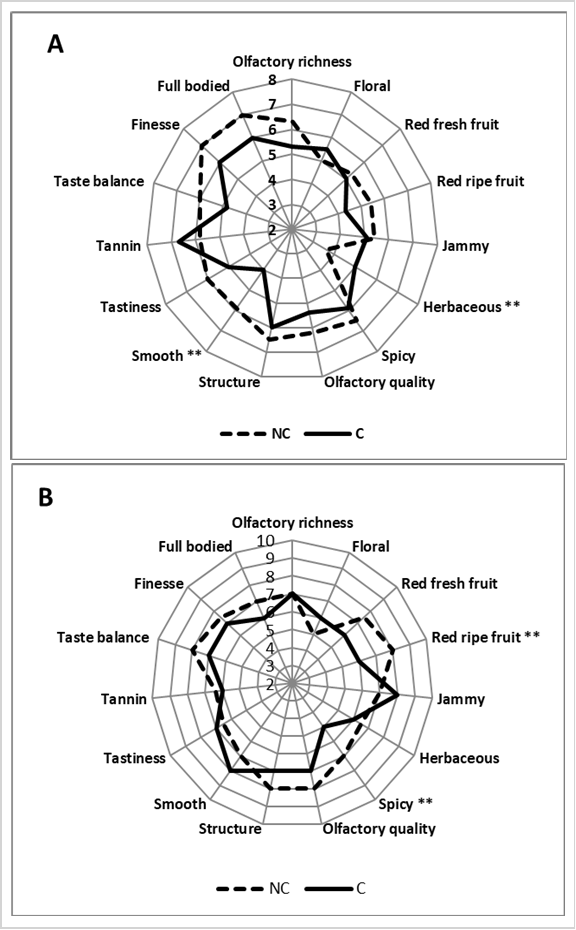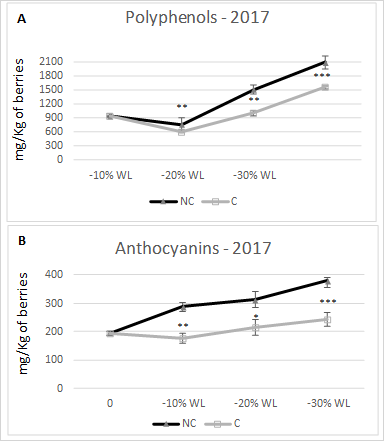By Diego Tomasi, Andrea Lonardi, Davide Boscaro, Tiziana Nardi, Christine Mayr Marangon, Mirko De Rosso, Riccardo Flamini, Lorenzo Lovat and Giovanni Mian*
*Correspondence: giovanni.mian@uniud.it
In the Valpolicella area (Verona, Italy) Vitis vinifera cv. Corvina is the main grape variety used to produce Amarone wine, which is stored in a withering warehouse until about 30% of the berry weight is lost, in order to obtain an enriched wine. For this study, the two grape-withering processes were carried out under controlled (C) and non-controlled (NC) conditions, at different weight loss timing (10, 20 and 30 % weight loss WL)and the final compositions of the Corvina dried grapes were compared also to evaluate the effects on the organoleptic characteristics of Amarone wine.
The microclimatic analysis of the chambers used for tests confirmed a different air thermal and humid regime in the two situations: lower temperatures and higher humidity in NC, higher temperatures, and lower humidity in C. Indeed, regarding the berry chemical composition, at the end of the studied period, the sugar content was higher in NC than in C. Measurements taken included acidity and its component in tartaric and malic acid. The accumulation trend was similar between treatments along the withering period, with a predominance, at the end, of total acidity in NC, mostly due to tartaric acid concentration. In more detail, tartaric acid was more stable and tended to re-main unaltered and even accumulate during the withering process at the different stages of WL, evidencing, as already stated, a greater concentration in NC conditions. Malic acid performed differently, showing a smaller conservation capability. Instead, the accumulation of polyphenols and anthocyanins evidenced an interesting trend showing an initial positive step linked to a new polyphenol and anthocyanin synthesis followed by a more stable phase (up to −20% WL). Finally, a third phase took place with the accumulation of the pigment compounds due to the concentration process. Specifically, NC tended to have more of both components than C during the withering process and, at −30% WL, significant differences were found in favour of NC. Yet, in this case, NC confirmed a higher accumulation capability, probably due to a slower and less stressful withering process linked to the higher temperature in C, capable of decreasing the synthesis or increasing the degradation of polyphenols and anthocyanins. Regarding stilbenes, in our research, the accumulation in the berry up to −20% WL was higher in the NC samples compared to the C ones, but in the latter case, the biosynthesis of stilbenes accelerated suddenly in the final withering stage (between 20–30% WL) by increasing their level in the berry. Yet, in terms of total aroma compounds, we found a higher content in NC, also confirmed by the better wine profile of these wines. In fact, concerning the sensory evaluations, the wines obtained confirmed the differences found in all analyses conducted on grapes. For NC, there were greater notes of spice (due to higher levels of benzenoids where the acetovanillone, vanillic alcohol and benzyl alcohol stand out) and a greater structure (given by the whole composition), which is also accompanied by greater finesse, elegance, and olfactory richness. Overall, it was a more harmonious, structured, and smooth wine (less tannicity) than C, where the unpleasant herbaceous notes tended to be higher. Similar outcomes confirming our research are reported in the literature.
In general, the drying process carried out in NC conditions was slower than in C due to higher RH, lower T and no air-forced movement in the NC environment. This slower process led to a major accumulation of sugars, acids, polyphenols and anthocyanins in NC. It is assumed that the slower process in NC was able to maintain vital cell structures for longer, with less water stress effects (lesser synthesis of stilbenes can confirm this observation). In terms of total aroma compounds, we found a higher content in NC, also confirmed by the better wine profile of these wines. Finally, to reach a considerable content of compounds and obtain balanced wines, we can report that it is desirable to reach a −30% WL and adopt NC conditions. Lastly, the sensory evaluation of wines highlighted the positive sensory descriptors present in the wines produced adopting the non-controlled process.


The present research confirmed that slowing down the drying process and creating less stressful conditions for the cells could be a strategic option to achieve a more traditional and well-appreciated Amarone wine and that choosing the traditional drying pro-cess carried out in natural conditions could also improve overall market appreciation.

Read all at: https://www.mdpi.com/1420-3049/26/17/5198

Giovanni Mian was born in Monfalcone on 24 July 1990, he is currently resident in Cormons and he comes from an agricultural reality. After finishing high school and obtaining the title of agricultural expert at ITAS Cividale, he worked for 2 years in various companies, related to the agricultural and non-agricultural world. After 2 years he decided to enroll in the Faculty of Agriculture (2012) completing his studies in October 2017. He then graduated in Agricultural Sciences and Technologies at the University of Udine with a 110 cum laude (master’s degree), discussing an experimental thesis on the genetic improvement of grape vine and table grape against mildews, using the technique called molecular marker assisted selection. Indeed, as a bachelor thesis he discussed an experimental thesis concerning the biofortification of Valerianella with selenium and interactions with sulfur metabolism, grown in hydroponic cultivation. Specifically, the theses have allowed him several publications in agrarian journals and agronomy-related sites. In particular, through the contribution given with the bachelor’s thesis, he won the Best Poster Prize award with his research group, at the Catholic University of the Sacred Heart. It also boasts an experimental marketing research concerning the different perception of consumers regarding the consumption of fresh fruit and specifically the kiwi. Mian is a willing, enterprising, sociable person with a great vocation for the research and experimentation sector and for this reason he can boast different work experiences in this sector, both in private companies (Sagea srl, Repros srl) and in public ones (ERSA Fvg and CREA VE). He likes dynamic work, both in contact with the environment and in the laboratory and office and wants to achieve his goals. It offers good knowledge of the sector and great motivation. The experience of the master and bachelor’s thesis together with the practical work / study allowed him to learn the main laboratory and field systems: use of general instrumentation, isolation of agrochemicals from plants, HPLC systems, test of agrochemicals in laboratory and field, enzymatic activity, elicitors analysis in plant, proteins and nucleic acid extraction and quantification protocols, PCR, use of capillary electrophoresis and electrophoresis on the gel of agarose, Gene Mapper software, field trialist (chemicals, decision support systems for Elateridae infection prediction, winter pruning) and the use of statistical software for the research (R).His main areas of interest are then experimentation and research, in the agronomic, chemical and genetic fields.





